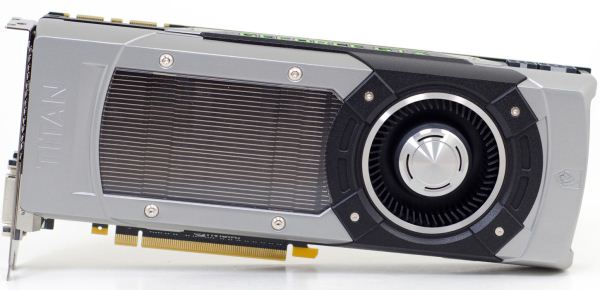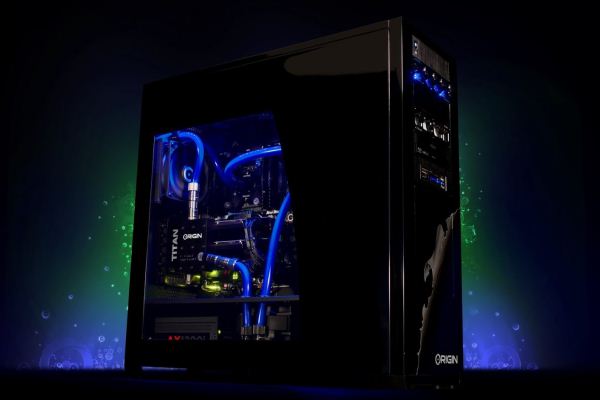NVIDIA’s GeForce GTX Titan Review, Part 2: Titan's Performance Unveiled
by Ryan Smith & Rahul Garg on February 21, 2013 9:00 AM ESTFinal Thoughts
Bringing things to a close, most of what we’ve seen with Titan has been a long time coming. Since the introduction of GK110 back at GTC 2012, we’ve had a solid idea of how NVIDIA’s grandest GPU would be configured, and it was mostly a question of when it would make its way to consumer hands, and at what clockspeeds and prices.
The end result is that with the largest Kepler GPU now in our hands, the performance situation closely resembles the Fermi and GT200 generations. Which is to say that so long as you have a solid foundation to work from, he who builds the biggest GPU builds the most powerful GPU. And at 551mm2, once more NVIDIA is alone in building massive GPUs.
No one should be surprised then when we proclaim that GeForce GTX Titan has unquestionably reclaimed the single-GPU performance crown for NVIDIA. It’s simply in a league of its own right now, reaching levels of performance no other single-GPU card can touch. At best, at its very best, AMD’s Radeon HD 7970GE can just match Titan, which is quite an accomplishment for AMD, but then at Titan’s best it’s nearly a generation ahead of the 7970GE. Like its predecessors, Titan delivers the kind of awe-inspiring performance we have come to expect from NVIDIA’s most powerful video cards.
With that in mind, as our benchmark data has shown, Titan’s performance isn’t quite enough to unseat this generation’s multi-GPU cards like the GTX 690 or Radeon HD 7990. But with that said this isn’t a new situation for us, and we find our editorial stance has not changed: we still suggest single-GPU cards over multi-GPU cards when performance allows for it. Multi-GPU technology itself is a great way to improve performance beyond what a single GPU can do, but as it’s always beholden to the need for profiles and the inherent drawbacks of AFR rendering, we don’t believe it’s desirable in situations such as Titan versus the GTX 690. The GTX 690 may be faster, but Titan is going to deliver a more consistent experience, just not quite at the same framerates as the GTX 690.
Meanwhile in the world of GPGPU computing Titan stands alone. Unfortunately we’re not able to run a complete cross-platform comparison due to Titan’s outstanding OpenCL issue, but from what we have been able to run Titan is not only flat-out powerful, but NVIDIA has seemingly delivered on their compute efficiency goals, giving us a Kepler family part capable of getting far closer to its theoretical efficiency than GTX 680, and closer than any other GPU before it. We’ll of course be taking a further look at Titan in comparison to other GPUs once the OpenCL situation is resolved in order to come to a better understanding of its relative strengths and weaknesses, but for the first wave of Titan buyers I’m not sure that’s going to matter. If you’re doing GPU computing, are invested in CUDA, and need a fast compute card, then Titan is the compute card CUDA developers and researchers have been dreaming of.
Back in the land of consumer gaming though, we have to contend with the fact that unlike any big-GPU card before it, Titan is purposely removed from the price/performance curve. NVIDIA has long wanted to ape Intel’s ability to have an extreme/luxury product at the very top end of the consumer product stack, and with Titan they’re going ahead with that.
The end result is that Titan is targeted at a different demographic than GTX 580 or other such cards, a demographic that has the means and the desire to purchase such a product. Being used to seeing the best video cards go for less we won’t call this a great development for the competitive landscape, but ultimately this is far from the first luxury level computer part, so there’s not much else to say other than that this is a product for a limited audience. But what that limited audience is getting is nothing short of an amazing card.
Like the GTX 690, NVIDIA has once again set the gold standard for GPU construction, this time for a single-GPU card. GTX 680 was a well-built card, but next to Titan it suddenly looks outdated. For example, despite Titan’s significantly higher TDP it’s no louder than the GTX 680, and the GTX 680 was already a quiet card. Next to price/performance the most important metric is noise, and by focusing on build quality NVIDIA has unquestionably set the new standard for high-end, high-TDP video cards.
On a final note, normally I’m not one for video card gimmicks, but after having seen both of NVIDIA’s Titan concept systems I have to say NVIDIA has taken an interesting route in justifying the luxury status of Titan. With the Radeon HD 7970 GHz Edition only available with open air or exotic cooling, Titan has been put into a position where it’s the ultimate blower card by a wide margin. The end result is that in scenarios where blowers are preferred and/or required, such as SFF PCs or tri-SLI, Titan is even more of an improvement over the competition than it is for traditional desktop computers. Or as Anand has so eloquently put it with his look at Falcon Northwest’s Tiki, when it comes to Titan “The days of a high end gaming rig being obnoxiously loud are thankfully over.”
Wrapping things up, on Monday we’ll be taking a look at the final piece of the puzzle: Origin’s tri-SLI full tower Genesis PC. The Genesis has been an interesting beast for its use of water cooling with Titan, and with the Titan launch behind us we can now focus on what it takes to feed 3 Titan video cards and why it’s an impeccable machine for multi-monitor/surround gaming. So until then, stay tuned.












337 Comments
View All Comments
chizow - Saturday, February 23, 2013 - link
The usage is fine, as it's in reference to Nvidia's practice of overcharging it's customers with exorbitant price increases. That's usury.The "entitlement" comes from helping to build Nvidia from a rinky dink GPU company into the global factor it is today by spending a few thousand dollars every few years on their glorified gaming machines.
The outrage comes from that company thinking it's OK to suddenly up the ante and charge you 2x as much for the same class and level of performance you'd expect from what you've paid every few years in an upgrade.
It's obvious you've never bought into this market before, because you'd feel more invested in what has happened in the landscape of desktop GPUs since the 7970 launch and the rest of Kepler launch and understand what is happening here. I don't plan to buy it as most others I know who have bought in this range of GPU before, most of whom have similar sense of disappointment and disdain for Nvidia's Titan pricing strategy.
As for the last bit...Nvidia has sold their 500+mm^2 ASIC GPUs for much less than even $500 in the past, hell the GTX 285 sold for as low as $330 and even the past GPUs with reported "terrible" yields like the GT200 and GF100 were sold for $500 in quarters where Nvidia still turned a profit. TSMC is charging slightly more per 300mm wafer at 28nm than previous nodes, but nothing close to the 100% premium being asked for with TITAN. So obviously they could sell it for less and still profit, they just chose not to.
CeriseCogburn - Saturday, February 23, 2013 - link
You're an IDIOT.nVidia sells these for THOUSANDS EACH, and production is LIMITED, you idiot gasbag fool.
The fact that they spare a few dies for a grand shows they are being extremely generous with their profit potential and giving you sick ungrateful whining losers a big freaking break !
But you're FAR TOO STUPID to know that. That's why nVidia has a REAL CEO and you're a crybaby whiner FOOL on the internet, who cannot think past his own insane $360 card budget, AND GETS IT 100% INCORRECT.
When nVidia sells one of these limited production monsters to one of you whining ungrateful OWS crybaby losers for a $1000.00, they are LOSING A COUPLE GRAND IN PROFITS, YOU IDIOT !
Have a nice, dumbed down, idiot crybaby loser day.
chizow - Saturday, February 23, 2013 - link
Production isn't limited, Nvidia and the article have shot that down from the outset, so please stop trying to use that as some "limited" production excuse.Nvidia will make as many of these as demand dictates, but they could've just as easily charged $300-400 less and sold untold magnitudes more GK110-based cards. That's the general impression I'm getting from all over the internet and from the circles of enthusiast I've encountered, anyways.
Pricing these at $1K is like stealing candy from a retarded kid (you), but $600-$700 would be justified based on expected price and performance relative to previous generations and worth a look at 1 or even 2 for any enthusiast who purchased in the enthusiast range before and still allowed Nvidia to charge a premium for Kepler's overachieving performance numbers.
CeriseCogburn - Sunday, February 24, 2013 - link
No, they shot down the only 10,000 amd fanboy liar rumor, and claimed there will be "continuing availability".So you're a liar and a fool.
chizow - Sunday, February 24, 2013 - link
Exactly, you said these were "limited" when they are not, so you stand corrected.Looks like you're the liar and the fool, but why state the obvious?
CeriseCogburn - Sunday, February 24, 2013 - link
They are limited, production is NOT limitless, a gradeB skumbag fool who needs a clue from a real authority to use common sense (to paraphrase your prior stupid remark) would know that.nVidia CANNOT produce whatever demand is whenever demand goes over production capacity, and the price you want, you have implied it would.
So go blow it out your tinfoil hat.
chizow - Monday, February 25, 2013 - link
Production is limited by demand with GK110, not some artificial "limited" production warranting the $1K price tag as you implied. But why state the obvious about the law of supply and demand?Please stop trying to cover your tracks with dishonesty, you were wrong to say Titan is limited when it was not, now move along.
CeriseCogburn - Tuesday, February 26, 2013 - link
Moving along would be you checking production capacity and the dates in question, of course instead you've gourd bolted reynolds wrap.CeriseCogburn - Saturday, February 23, 2013 - link
Yes mlambert908, they are spoiled lying crybaby children.Thanks for being another sane voice in the wilderness.
The crybabies need to become men and earn a living, so they stop embarrassing themselves. Not that they know or understand that, nor that they ever will, but it gets sickeningly redundant when they poo their diapers all over the place every time.
How about they grow up, get to work, and buy a video card once without whining like spoiled brats for months on end over the evil overlords who just won't give them a huge break because... they demand it.
Maybe the Illegal Usurper will start enforcing price controls for them in this crappy economic worldwide situation where ALL prices have been rising greatly for a number of years.
Perhaps the fantasy world the brat fanboy crybabies live in is actually a sheltered virtual unreality absolutely separate from RL.
Charlie D's slaves, with deranged fantasy brains, and like you said, one of the sickest cases of entitlement the world has ever seen.
chizow - Saturday, February 23, 2013 - link
It's funny that you keep mentioning Charlie D., your asinine rants make him look like a genius and a prophet.